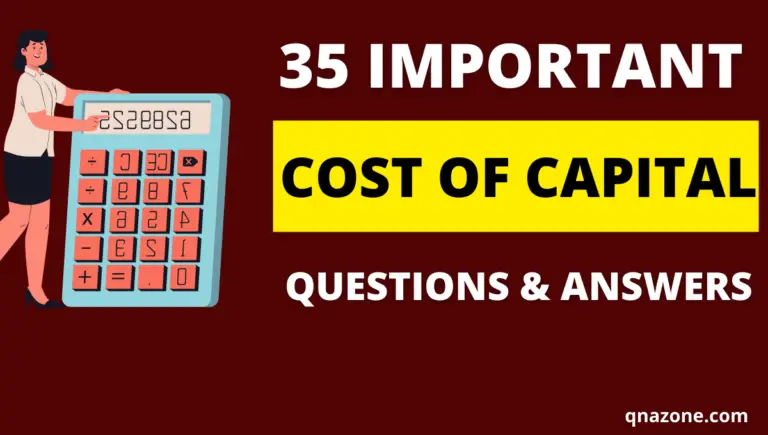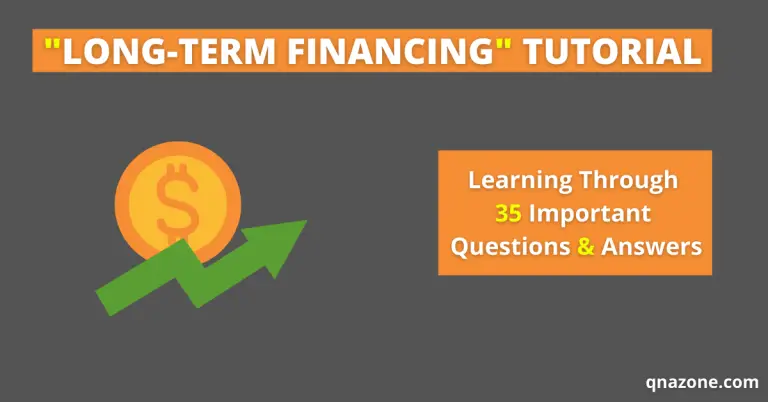35 Important Short-Term and Mid-Term Financing Questions and Answers [With PDF]
The 3rd chapter of our finance learning course is “Short-Term and Mid-Term Financing”. In this article, we’ll learn the 35 most important Short-term and Mid-term Financing questions and their answers.
It will help you understand the important Short-term and Mid-term Financing terms and their explanations quickly.
You can read the first two chapters of our finance learning course here if you missed them.
- 25 Introduction to Finance Questions and Answers [With PDF]
- 30 Important Time Value of Money Questions and Answers [With PDF]
By reading this post, you may quickly prepare for finance courses and for any competitive tests such as school and college exams, vivas, job interviews, and so on.
So let get started…
Short-Term and Mid-Term Financing Questions and Answers:
The 35 most important Short-term and Mid-term Financing questions and answers are as follows:
Question 01: What is Short Term Financing?
Answer: Financing that is usually for a period of one year or less is called short-term financing. Short-term financing is provided for the working capital of the business or for carrying out day-to-day operations.
Question 02: What are the Features of Short Term Financing?
Answer: The important features of short term financing are as follows:
- Short-term financing is usually for one year or less.
- Short-term financing is used to meet the working capital requirements of a business.
- The cost of short-term financing tends to be lower.
- Securities are not required for informal sources of short-term financing.
- Short-term financing is renewable.
- The method of raising short-term financing is relatively simple.
Question 03: What are the Advantages of Short Term Financing?
Answer: The advantages of short term financing are as follows:
- Compared to other loans, short-term loans can be collected very easily.
- The cost of short-term financing is very low compared to other loans.
- Short-term financing is relatively more flexible than medium-term and long-term financing.
- Lenders offer simple terms for short-term loans compared to other loans.
- Short-term financing and repayment times are shorter, so lender risk is lower.
- Most short-term financing does not require collateral
Question 04: What are the Disadvantages of Short Term Financing?
Answer: The disadvantages of the short term loan are as follows:
- It is not possible to raise a large number of funds from a source of short-term financing.
- Since the term of short-term financing is less than one year, the loan taken can be provided for a very short period of time.
- It is riskier to repay such a loan in a short period of time.
- When traders make short-term financing by buying goods on credit, the price of their purchased goods goes up.
Question 05: What are the Sources of Short Term Financing?
Answer: The sources of short term financing are as follows:
Informal Sources:
- Spontaneous Financing
- Trade Credit
- Advance from Customer
- Accrued Expenses
Formal Sources:
- Money Market Loan
- Unsecured Loan
- Secured Loan
Question 06: What is Trade Credit?
Answer: Trade credit refers to the credit that a customer gets from the supplier of goods in the normal courses of business. Trade credits are very popular in the business world today. Because business trade credits do not require any formalities or collateral.
Question 07: What are the Features of Trade Credit?
Answer: The important features of the trade credit are as follows:
- Trade credits originate from the purchase or sale of goods on credit or for the purpose of resale.
- As a result of the goodwill of buyers and sellers, trade credit activities are carried out.
- The formality of a business loan is much less than the formality of a bank loan.
- No collateral is required for trade credits.
- The cost of trade credit is low.
- The amount of trade credit is less, so the risk of repayment is also less.
Question 08: What is the Formula for calculating the Cost of Trade Credit (CTC)?
Answer:
Cost of Trade Credit (CTC) = % of Discount/(100-% of Discount) X 360/(Payment Period-Discount Period)
Question 09: What are the Reasons for Trade Credit’s Popularity?
Answer: The following are the reasons for the popularity of trade credits:
- Trade credit is widely available.
- Trade credit has a much lower cost than bank loans. As a result, its application is expanding.
- Obtaining a bank loan entails numerous formalities; however, obtaining a trade credit is simple.
- There is less risk if the trader finances through trade credit.
- There is no need for collateral for trade credit.
Question 10: What is the difference between a Bank Loan and a Trade Credit?
Answer: The following are the differences between a bank loan and a trade credit:
- A bank loan is a loan given by a bank; on the other hand, trade credit is when a commodity is bought and sold on loan for the purpose of resale.
- Bank loans are made in cash, whereas trade credits are not made in cash.
- Bank loans require interest, whereas trade credits do not.
- Bank loans necessitate collateral, whereas trade credits do not.
- Bank loans have multiple conditions, whereas trade credits do not.
Question 11: What is a Commercial Paper?
Answer: A commercial paper is a type of unsecured, short-term transferable pledge that is sold in the currency market to meet the working capital needs of large and financially viable businesses.
Question 12: What is the Formula for Calculating Cost of Commercial Paper?
Answer: Cost of Commercial paper (CCP) = ((Face Value-Net Sales Price)/Net Sales Price) x (360/Days of Maturity)
Question 13: What is Mid-Term Financing?
Answer: The financing that is usually done for more than one year but less than 5 or 7 or 10 years is called mid-term financing. Small and medium enterprises use this type of financing more.
Question 14: What are the Characteristics of Mid-Term Financing?
Answer: The following are the key characteristics of mid-term financing:
- Mid-term financing is typically obtained for a period of 5 or 6 years rather than a period of more than one year.
- The amount of a mid-term loan is typically less than that of a long-term loan.
- This type of financing is used by all types of small and medium-sized businesses.
- The majority of businesses use mid-term financing to meet current capital needs, expand equipment, and replace, among other things.
- Typically, mid-term financing is paid in installments.
Question 15: What are the Sources of Mid-Term Financing?
Answer: The main sources of mid-term financing are as follows:
- Commercial Bank
- Insurance Company
- Development Bank
- Development Organization
- Finance Company
- Leasing Company
Question 16: Who are the Users of Mid-Term Financing?
Answer: The users of mid-term financing are as follows:
- Manufacturing Organization
- Service Organization
- New and Small Enterprise
- Medium and Lange Enterprise
- Farmers
Question 17: What are The Advantages or Benefits of Mid-Term Financing?
Answer: The following are the advantages or benefits of mid-term financing:
- The great advantage of mid-term financing is its flexibility. In the case of such borrowing, the borrower can take the loan as needed and enjoy flexibility in terms of renewal.
- It is more convenient to repay the loan in installments because such loans can be repaid in installments.
- Loan agreements for the mid-term are easily renewable. This loan is easily convertible into a long-term loan.
- This type of loan is suitable for quick financing.
- Less formality is required in the case of such financing.
Question 18: What is Working Capital?
Answer: Working capital is the capital required for an organization’s day-to-day operations. In other words, working capital is the sum of an organization’s total current assets, which include cash, bank deposits, bills receivable, various debtors, stocks, and so on.
Question 19: What is the Optimum Level of Working Capital?
Answer: The amount of working capital required to keep production running, including managing an organization’s day-to-day operations, is referred to as the optimum level of working capital. In other words, the optimum level of working capital is the amount of working capital that is neither too much nor too little.
Question 20: Which Factors that Influence Working Capital?
Answer: The factors that influence working capital are as follows:
- Business Size
- Business Nature
- Working Capital Cycle
- Raw Material Nature
- Sales Volume
- Production Principle
- Loan Availability
Question 21: What is the Classification of Working Capital?
Answer: The classification of working capital is as follows:
Based on Assumption:
- Gross Working Capital
- Net Working Capital:
- Positive Working Capital
- Negative Working Capital
Based on Time:
- Fixed Working Capital
- Variable Working Capital
Question 22: What is Variable Working Capital?
Answer: The change in working capital over time is called variable working capital. Such working capital usually depends on the increase and decrease of demand for the product.
Question 23: What Is the Distinction between Total and Net Working Capital?
Answer: The three main distinctions between total working capital and net working capital are as follows:
- Total working capital is the sum of an organization’s current assets; net working capital is the net balance after deducting current liabilities from current assets.
- Total working capital equals the sum of total current assets; net capital equals total current assets minus total current liabilities.
- Managing liquidity based on total working capital is difficult, whereas managing liquidity based on net-working capital is simple.
Question 24: What is the Difference between Fixed Capital and Working capital?
Answer: The following is the difference between fixed capital and working capital:
- Fixed capital refers to the portion of total capital invested in fixed assets, whereas working capital refers to the amount of cash required for the smooth operation of the day-to-day business.
- Fixed capital is represented by fixed assets. For example, land, buildings, machinery, and so on; on the other hand, current assets are used to express the business’s working capital. For instance, cash, stocks, bills receivable, marketable securities, and so on.
- The fixed capital cost is relatively high, while the working capital cost is relatively low.
Question 25: What is Working Capital Management?
Answer: Working capital management refers to the management of an organization’s current assets, such as cash, bank deposits, receivables, stocks, miscellaneous debtors, and so on.
Question 26: Which Three Principles do an Organization have to Follow in order to Raise the Working Capital?
Answer: The following three principles does an organization have to follow to raise working capital:
- Matching Policy
- Conservative policy
- Aggressive Policy
Question 27: What is the Working Capital Cycle?
Answer: The working capital cycle refers to the period between the time payment is made to pay the cost of production and the value of the goods is received from the debtor.
Question 28: What is the Cash Cycle?
Answer: A firm’s cash cycle refers to the period during which it purchases raw materials with cash outflows, uses them to manufacture goods, and collects cash by selling them in the market.
Question 29: What are Receivables?
Answer: Receivables are asset accounts that represent amounts owed to the company as a result of the sale of goods or services in the normal course of business.
Question 30: What are the Objectives of Receivable Management?
Answer: The three main objectives of receivables management are as follows:
- Increase in Sales
- Increase of Profit
- Dealing with competition
Question 31: What is Inventory Management?
Answer: Inventory management is the proper control and strategy for the amount of stock required to run a business. So that there is no risk of loss due to a lack or excess of stock products for conducting business.
Question 32: What are the Three Most Important Aspects of Inventory Management?
Answer: The three most important aspects of effective inventory management are as follows:
- Economic Order Quantity (EOQ)
- The Reorder Point; and
- The Stock Level
Question 33: What are the Objectives of Inventory Management?
Answer: The objectives of inventory are as follows:
- Production according to demand
- Minimize investment in stocks
- Ensure delivery of products to buyers
- Optimal use of stocks
- Reduce damage
Question 34: What is Economic Order Quantity (EOQ)?
Answer: An economic order quantity is the order size associated with the lowest cost.
Question 35: What are the Three Methods of Calculating Economic Order Quantity (EOQ)?
Answer: The three methods of calculating economic order quantity are as follows:
- Equation Method
- Trial and Error Method
- Graphical Method
I hope that by the end of this post, you have a good understanding of the “Short-Term and Mid-Term Financing” chapter.
You will gain a better understanding of the “Short term and Mid-term Financing” chapter if you read these 35 important Short-Term and Mid-Term Financing questions and answers on a regular basis.
You can also read:





